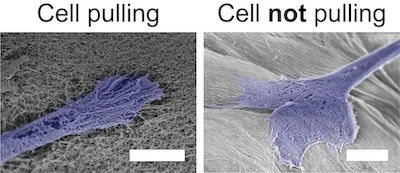An international group of bioengineers and chemists from Rice University and the University of Houston have made great progress toward developing a biomaterial that can be used to cultivate biological tissues outside of the human body. The research was published in the journal ACS Nano.

Scanning electron micrographs of cells pulling on nanofibers with lower alignments but not pulling on nanofibers with higher alignments. Cells are falsely colored blue (scale bars = 5 mm). Image Credit: Adam Farsheed/Rice University
The development of a new fabrication process to create aligned nanofiber hydrogels could offer new possibilities for tissue regeneration after injury and provide a way to test therapeutic drug candidates without the use of animals.
Led by Jeffrey Hartgerink, professor of chemistry and bioengineering, the research team has devised peptide-based hydrogels mirroring the aligned structure of muscle and nerve tissues. Achieving alignment is crucial for tissue functionality, yet replicating this feature in the lab presents a significant challenge due to the need to align individual cells.
The group has been creating multidomain peptides (MDPs) that self-assemble into nanofibers for more than a decade. These are similar to the naturally occurring fibrous proteins in the body, like a nanoscale spiderweb.
In their latest study, the researchers unveiled a new technique for generating aligned MDP nanofiber "noodles." Initially dissolving the peptides in water, they subsequently extruded them into a saline solution, yielding aligned peptide nanofibers resembling twisted strands of rope, each smaller than a cell.
By elevating the concentration of ions, or salt, in the solution and iterating the process, they attained an even more pronounced alignment of the nanofibers.
Our findings demonstrate that our method can produce aligned peptide nanofibers that effectively guide cell growth in a desired direction, this is a crucial step toward creating functional biological tissues for regenerative medicine applications.
Adam Farsheed Ph.D., Study Lead Author, Department of Bioengineering, Rice University
One of the crucial findings of the study was an unexpected discovery: overly strong alignment of the peptide nanofibers prevented the cells from aligning. Further exploration indicated that for cells to detect and respond to the alignment, they need the ability to exert tension on the peptide nanofibers. If the nanofibers are excessively rigid, the cells are unable to apply this force, resulting in their failure to organize into the intended configuration.
This insight into cell behavior could have broader implications for tissue engineering and biomaterial design. Understanding how cells interact with these materials at the nanoscale could lead to more effective strategies for building tissues.
Jeffrey Hartgerink, Professor, Chemistry and Bioengineering, Rice University
Additional study co-authors from Rice University are Chemistry Department Ph.D. graduates Tracy Yu and Carson Cole, graduate student Joseph Swain, and undergraduate researcher Adam Thomas. From the bioengineering department, undergraduate researcher Jonathan Makhoul, graduate student Eric Garcia Huitron, and Professor K. Jane Grande-Allen also contributed as co-authors.
The collaborative team from the University of Houston includes Ph.D. student Christian Zevallos-Delgado, research assistant Sajede Saeidifard, research assistant professor Manmohan Singh, and engineering professor Kirill Larin.
This research received partial funding from several prestigious sources, including grants from the National Institutes of Health (NIH) under grant numbers R01DE021798, R01EY022362, R01HD095520, and R01EY030063. Additional support was provided by the National Science Foundation (NSF) under grant number 2129122 and the NSF Graduate Research Fellowship Program. The Welch Foundation also contributed, offering support under grant C-2141.
MDPNoodleVideo
Video Credit: Rice University
Journal Reference:
Farsheed, C. A., et al. (2024) Tunable Macroscopic Alignment of Self-Assembling Peptide Nanofibers. ACS Nano. doi.org/10.1021/acsnano.4c02030.
Article Revisions
- May 6 2024 - Title changed from "Engineering Tissue-Mimicking Material for Regeneration" to "Revolutionizing Regenerative Medicine: Groundbreaking Biomaterial for Tissue Growth"